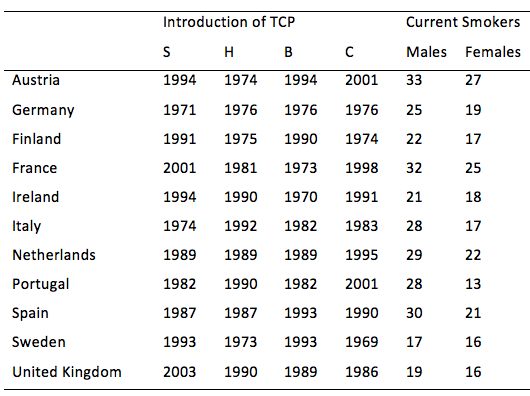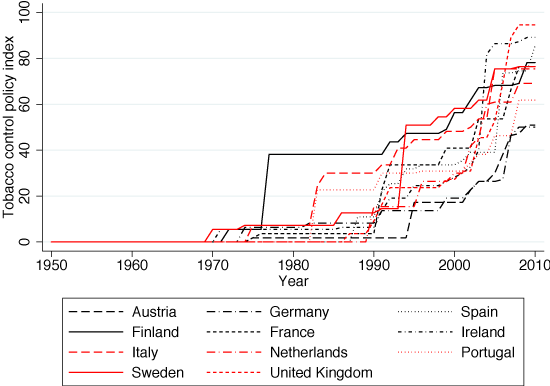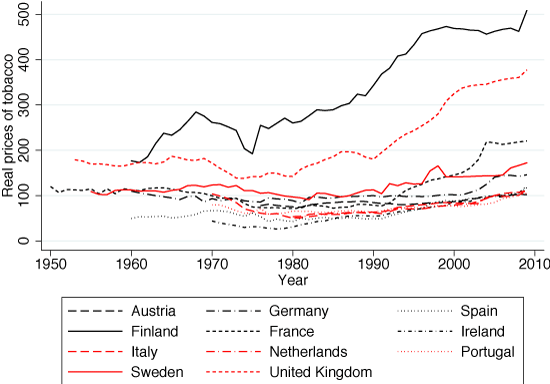Tobacco use is one of the biggest health threats ever, killing one person approximately every six seconds (Mathers et al. 2012). The WHO considers it an epidemic, and nearly 6 million people die every year because of tobacco related diseases, a number which is expected to reach 8 million by 2030.
Due to the serious negative health effects of tobacco use, many governments in the world today try to influence its use through various substance control policies. First and foremost, tobacco taxes are used as a tool to increase its prices with the goal of discouraging people from smoking. There are also non-price tobacco control policies, such as prohibition or restriction of advertisements of cigarettes (or any tobacco products in general), laws necessitating the placement of health warnings and pictures on tobacco product packages, different types of anti-smoking campaigns, and laws prohibiting the use of tobacco in certain places. Nearly one third of the world’s population is covered by at least one type of comprehensive non-price tobacco control policy, and a considerable amount of resources is spent to enforce these policies (WHO 2013).
To what extent tobacco control policies actually affect smoking is an empirical question. Past research on the effects of tobacco control policies is not conclusive. Whereas tobacco prices, bans on cigarette advertisements, and placement of health warnings on tobacco and cigarette packages seem to have had a negative effect on the number of smokers and the per capita cigarette consumption, this is less clear for smoking bans (i.e. restrictions on smoking in public places and workplaces). Some studies find a negative effect on smoking, while others find no effect.
Saffer and Chaloupka (2000) and Blecher (2008) find that prohibiting advertisements of cigarettes has a significant negative impact on per capita cigarette consumption. Meier and Licari (1997) and Chaloupka and Grossman (1996) find that health warnings on packages of cigarettes have small but significant negative effects on tobacco consumption.
Chaloupka and Wechsler (1997) and Powell et al. (2005) find strong negative effects of smoke-free air policies on tobacco use. However, Adda and Cornaglia (2010) find that laws prohibiting smoking at workplaces do not have any effect on smoking prevalence or per capita consumption. Similarly, Anger et al. (2011) and Cott et al. (2016) find that, on average, smoke-free legislation does not affect smoking behaviour.
The vast majority of these studies in the literature show that there is not yet a consensus on the effects of tobacco control policies. Moreover, the studies focus on per capita or total cigarette consumption or on smoking prevalence. Dynamics in smoking behaviour – i.e. starting and quitting – are ignored. In our research, we use a different approach and focus on smoking initiation – i.e. how smoking initiation is affected by various tobacco control policies (see Palali and Van Ours 2017).
Tobacco control policies and prevalence of smoking
Although tobacco control policies are common today, this was not the case a few decades ago. The 1964 Surgeon General’s report gradually changed the public’s opinion about tobacco use when it became clear that there are several adverse health consequences related to smoking. Together with public opinion, government policies towards tobacco and tobacco use started to change both in the US and in Europe.
Table 1 Tobacco control policies: First year in which a policy was implemented, percentages of current smokers
Notes: S = Smoke-free air; H = Health warnings; B = Bans on advertisements; C = Cessation policies. Percentages of current smokers relate to the adult population. Information from 2014.|
Source: Eurostat (except Ireland); Ireland: National Tobacco Control Office.
Table 1 shows that the first tobacco control policies implemented were mainly bans on advertising and health warnings on packages. Among the 11 European countries in our empirical analysis, six had already passed some restrictive regulations on tobacco advertisements in 1985, five did so a few years later. By 1990, almost all countries had meaningful restrictions on advertising and health warnings on packages. The last two columns show the prevalence rates of smoking among males and females separately. Current smokers as percentages of the population range from 17% to 33% among males and from 13% to 27% among females. Austria, the country with the highest share of smokers, has about twice as many smokers per adult as the country with the lowest share of smokers, Sweden.
To establish how smoking initiation is affected by tobacco control policies, we need to quantify government policies. To do so, we use the Tobacco Control Policy Index (TCPI) as an indicator. The TCPI has four main components: smoke-free air laws, bans on advertising promotion and sponsorship, health warnings on tobacco product packaging, and smoking cessation treatment policies. Nguyen et al. (2012) created the TCPI adopting the scoring system introduced by Joossens and Raw (2006). It allocates points to several components of each policy. Smoke-free air laws policy, for example, has four components: bans in cafes and restaurants, bans in public transportation, bans in other public places, and bans in workplaces. The overall index reflects the sum of the scores given to each of the four policies, which themselves are sums of the scores given to each of the components
Figure 1 displays the evolution of the TCPI in 11 European countries from 1950 to 2010. Before 1969, the index remains at zero because there was no tobacco control policy in any of the 11 countries. After 1969, the index slightly increases in many countries, and after 1990 it starts increasing rapidly. There are significant differences between countries for all tobacco control policies, as the first implementation dates and the levels of policy scores differ considerably. Such differences also exist in the tobacco prices.
Figure 1 Tobacco Control Policy Index in 11 European countries, 1950-2010
Source: Nguyen et al. (2012)
Figure 2 shows the trends in real tobacco prices in 11 countries. Even though real prices of tobacco have been increasing over time in all countries, the increase is much steeper in some countries such as Finland and the UK than it is in other countries.
Figure 2 Tobacco prices in 11 European countries, 1950-2010
Source: Nguyen et al. (2012)
Our analysis
To investigate the effects of tobacco control policies on smoking initiation, we merge two data sources. The first data source is the special Eurobarometer 429 covering residents in EU member states aged 15 years and over. The starting point of the survey was the question: “Regarding smoking cigarettes, cigars, cigarillos or a pipe, which of the following applies to you?”. If the answer was “currently smoke” or “used to smoke but has stopped”, the following question was: “How old were you when you started smoking on a regular basis, i.e. at least once a week?”. We use this retrospective information to reconstruct the history of smoking initiation necessary to model the starting rates of tobacco use. The second data source is Nguyen et al. (2012), which provides information on indices for tobacco control policies for several European countries. Merged data set consists of 4500 observations, approximately 400 individuals from 11 European countries: Austria, Germany, Finland, France, Ireland, Italy, the Netherlands, Portugal, Spain, Sweden, and the UK. We use hazard rate models in our analysis to explain smoking initiation rates by age.
Thus, we can take into account observable and unobservable factors that may affect smoking initiation. There are two main sources for our identification. The first one is that although within a country in a particular year the same smoking restrictions apply to all individuals in that country, the effect of a smoking restriction at a particular age depends on the year of birth of the individual. The second source is the cross-country variation in years in which tobacco control policies are applied in different countries. Therefore, we use a before–after approach in a hazard rate framework where the before–after variation is caused by the introduction of tobacco control policies in a particular year and in a particular country.
In our analysis, we control for educational attainment of the individuals, urbanisation status of the residence, and country-specific birth year and calendar time trends. We find that the starting rate of smoking decreases with educational attainment and is age-specific, and for males we find that it decreases with tobacco prices. Our main result is that non-price tobacco control policies have no significant effect on the age of onset of smoking either for males or females. Current tobacco control policies do not seem to discourage young individuals from starting to smoke. This does not imply that current tobacco control policies are all together ineffective in reducing smoking since they could have reduced the intensity of smoking or stimulated the quit rate from smoking. Nevertheless, our main findings are alarming because preventing young people from starting to smoke should be as important as trying to reduce their consumption or trying to convince them to quit once they have started. Thus, special tobacco control policies need to be designed to prevent youngsters from starting to smoke. This can help governments in their fight against tobacco use in the general population.
References
Adda, J, and F Cornaglia (2010), “The effect of bans and taxes on passive smoking”, American Economic Journal: Applied Economics, 2 (1), 1-32.
Anger, S, M Kvasnicka, and T Siedler (2011), “One last puff? Public smoking bans and smoking behaviour”, Journal of Health Economics, 30 (3), 591-601.
Chaloupka, F, and M Grossman (1996), “Price, tobacco control policies and youth smoking”, NBER Working Paper No 5740.
Chaloupka, F, and H Wechsler (1997), “Price, tobacco control policies and smoking among young adults”, Journal of Health Economics, 16 (3), 359-373.
Cott, C, E Nesson, and N Tefft (2016), “The effects of tobacco control policies on tobacco products, tar, and nicotine purchases among adults: Evidence from household panel data”, American Economic Journal: Economic Policy, 8 (4), 103-123.
Joossens, L ,and M Raw (2006), “Tobacco control scale: a new scale to measure country activity”, Tobacco Control, 15, 247-253.
Meier, K, and M Licari (1997), “The effect of cigarette taxes on cigarette consumption, 1955 through 1994”, American Journal of Public Health, 87, 1126-1130.
Nguyen, L, G Rosenqvist, and M Pekurinen (2012), “Demand for Tobacco in Europe, An Econometric Analysis of 11 Countries for the PPACTE Project Helsinki”, National Institute for Health and Welfare.
Palali, A, and J C van Ours (2017), “The Impact of Tobacco Control Policies on Smoking Initiation in Europe”, CEPR Discussion Paper 12201.
Powell, L M, J A Tauras, and H Ross (2005), “The importance of peer effects, cigarette prices and tobacco control policies for youth smoking behaviour”, Journal of Health Economics, 24 (5), 950-968.
Saffer, H, and F Chaloupka (2000), “The effect of tobacco advertising bans on tobacco consumption”, Journal of Health Economics, 19 (6), 1117-1137.
WHO (2013), Report on the global tobacco epidemic, Geneva: World Health Organization.






